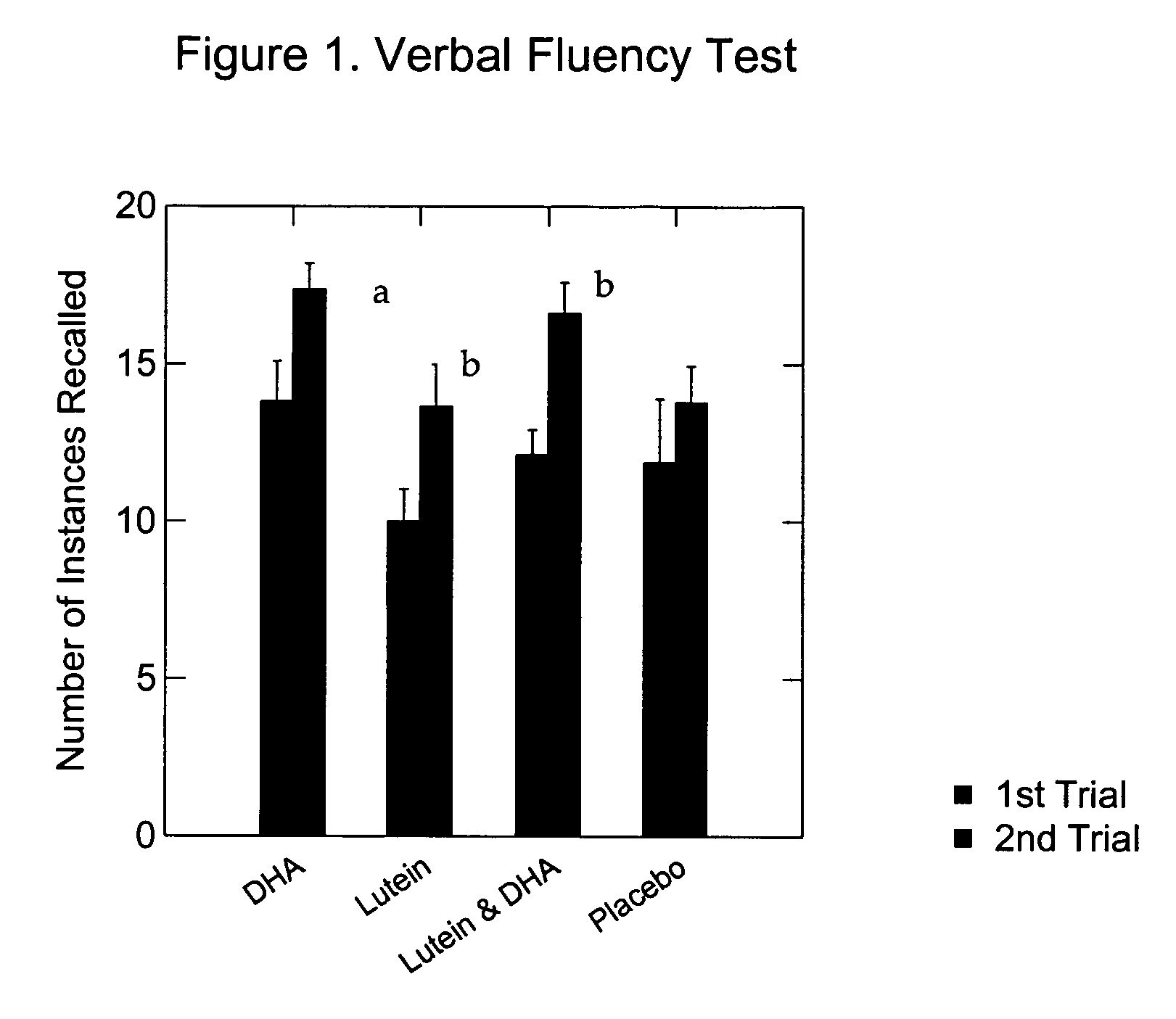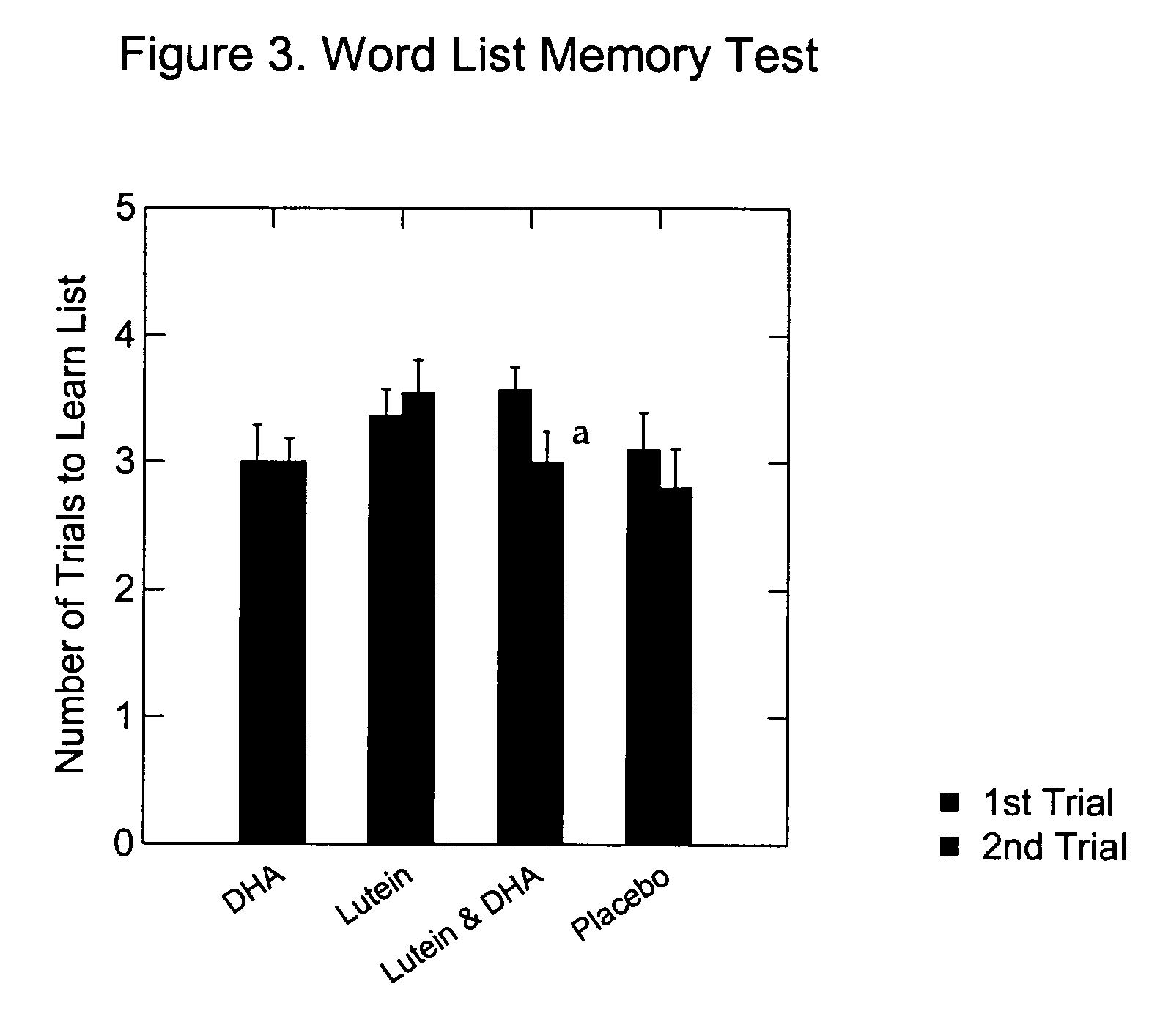Synergistic effects of docosahexaenoic acid (DHA) and carotenoid absorption on macular pigmentation
- Summary
- Abstract
- Description
- Claims
- Application Information
AI Technical Summary
Benefits of technology
Problems solved by technology
Method used
Image
Examples
example 1
Study Design and Methods
[0068] Subjects: Fifty non-smoking women (60-80 years) were recruited from the general population for a 4 month supplementation study. All subjects underwent a screening examination that includes a medical history, a physical examination, and a routine blood clinical chemistry profile. Volunteers with any history or biochemical evidence of lactose intolerance, liver, kidney, or pancreatic disease, anemia, active bowel disease or resection, insulin-dependent diabetes, easy bruising or bleeding, bleeding disorders, hyperglyceridemia, hyperlipidproteinemia, or alcoholism were excluded from the study. Moreover, individuals taking mineral oil or medications suspected of interfering with fat-soluble vitamin absorption were excluded. Subjects using steroids or non-steroid anti-inflammatory drugs, or antihistamine drugs were excluded. Subject who had a vaccination within 2 weeks of the study screening were be excluded. Subjects were excluded if they have taken any n...
example 2
Results
Subjects.
[0085] Fifty-seven women were admitted for this study. Seven women dropped out of the study for the following reasons: medication use (1), autoimmune disease (1), unknown (1), aversion to study protocol (4). Therefore, the total number of women studies was 50. Subject characteristics at baseline are given in Table 1. Table 1 presents the age and education characteristics of each of the four study groups. At baseline, neither age nor years of education in the total sample (n=49) was significantly associated with cognitive test scores or self-reported mood scores. There were no significant differences in baseline measures of age, body mass index (kg / m2), serum concentrations of lutein and DHA, or MPOD. One subject in the LD group had an increase in the confluence of soft drusen. No other subjects had indications of ocular changes. In this age group it is not surprising that an occasional subject might show changes with time that are unrelated to the supplementation....
example 3
Relations Between Serum Nutrient Levels and Cognitive Performance
[0105] Table 4 shows correlations between final test scores and possible covariates (age and education), DHA and lutein serum levels, and an endpoint, macular pigment ocular density (MPOD), from the primary vision study. Of the test scores that changed significantly after supplementation, Verbal Fluency and Trials to Learn Shopping List scores were the least subject to ceiling effects in the total sample of subjects. In the full sample (n=49), of age and education, age was the only possible covariate that was significantly associated with final Verbal Fluency score. Although subjects' scores on the Verbal Fluency test at baseline did not differ significantly by age, younger subjects recalled more instances of a category than older subjects at the end of the study.
TABLE 4Correlations Between Variables After Supplementation.MIRShoppingWord ListApartmentVerbalList (Trials(TrialsDelayedFluencyto Learn)to Learn)RecallAge...
PUM
| Property | Measurement | Unit |
|---|---|---|
| Molar density | aaaaa | aaaaa |
| Molar density | aaaaa | aaaaa |
| Mass flow rate | aaaaa | aaaaa |
Abstract
Description
Claims
Application Information
 Login to View More
Login to View More - R&D
- Intellectual Property
- Life Sciences
- Materials
- Tech Scout
- Unparalleled Data Quality
- Higher Quality Content
- 60% Fewer Hallucinations
Browse by: Latest US Patents, China's latest patents, Technical Efficacy Thesaurus, Application Domain, Technology Topic, Popular Technical Reports.
© 2025 PatSnap. All rights reserved.Legal|Privacy policy|Modern Slavery Act Transparency Statement|Sitemap|About US| Contact US: help@patsnap.com



